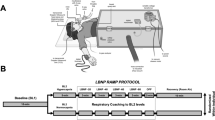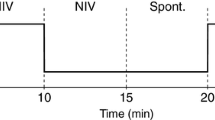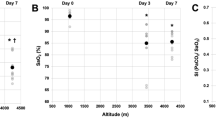Abstract
Both voluntary rebreathing (RB) of expired air and voluntary apneas (VA) elicit changes in arterial carbon dioxide and oxygen (CO2 and O2) chemostimuli. These chemostimuli elicit synergistic increases in cerebral blood flow (CBF) and sympathetic nervous system activation, with the latter increasing systemic blood pressure. The extent that simultaneous and inverse changes in arterial CO2 and O2 and associated increases in blood pressure affect the CBF responses during RB versus VAs are unclear. We instrumented 21 healthy participants with a finometer (beat-by-beat mean arterial blood pressure; MAP), transcranial Doppler ultrasound (middle and posterior cerebral artery velocity; MCAv, PCAv) and a mouthpiece with sample line attached to a dual gas analyzer to assess pressure of end-tidal (PET)CO2 and PETO2. Participants performed two protocols: RB and a maximal end-inspiratory VA. A second-by-second stimulus index (SI) was calculated as PETCO2/PETO2 during RB. For VA, where PETCO2 and PETO2 could not be measured throughout, SI values were calculated using interpolated end-tidal gas values before and at the end of the apneas. MAP reactivity (MAPR) was calculated as the slope of the MAP/SI, and cerebrovascular reactivity (CVR) was calculated as the slope of MCAv or PCAv/SI. We found that compared to RB, VA elicited ~ fourfold increases in MAPR slope (P < 0.001), translating to larger anterior and posterior CVR (P ≤ 0.01). However, cerebrovascular conductance (MCAv or PCAv/MAP) was unchanged between interventions (P ≥ 0.2). MAP responses during VAs are larger than those during RB across similar chemostimuli, and differential CVR may be driven by increases in perfusion pressure.


Similar content being viewed by others
Availability of data and material
The deidentified data from this study will be made available upon reasonable request by request to the corresponding author by a qualified researcher.
Code availability
Not applicable.
Abbreviations
- CBF:
-
Cerebral blood flow
- CBV:
-
Cerebral blood velocity
- MAP:
-
Mean arterial blood pressure
- MAPR:
-
Mean arterial blood pressure reactivity
- MCAv:
-
Middle cerebral artery blood velocity
- PCAv:
-
Posterior cerebral artery blood velocity
- P ETCO2/O2 :
-
Pressure of end-tidal CO2/O2
- SI:
-
Stimulus index (PETCO2/PETO2)
- CVR:
-
Cerebrovascular reactivity
- CVC:
-
Cerebrovascular conductance
- PaCO2/O2 :
-
Partial pressure of CO2/O2
References
Ainslie PN, Duffin J (2009) Integration of cerebrovascular CO2 reactivity and chemoreflex control of breathing: mechanisms of regulation, measurement, and interpretation. Am J Physiol Regul Integr Comp Physiol 296(5):R1473–R1495
Ainslie PN, Hoiland RL (2014) Transcranial Doppler ultrasound: valid, invalid, or both? J Appl Physiol 117:1081–1083
Bain AR, Ainslie PN, Barak OF, Hoiland RL, Drvis I, Mijacika T, Bailey DM, Santoro A, DeMasi DK, Dujic Z, MacLeod DB (2017) Hypercapnia is essential to reduce the cerebral oxidative metabolism during extreme apnea in humans. J Cereb Blood Flow Metab 37:3231–3242
Bålfors EM, Franklin KA (1994) Impairment of cerebral perfusion during obstructive sleep apneas. Am J Respir Crit Care Med 150:1587–1591
Battisti-Charbonney A, Fisher J, Duffin J (2011) The cerebrovascular response to carbon dioxide in humans. J Physiol 589:3039–3048
Bruce CD, Steinback CD, Chauhan UV, Pfoh JR, Abrosimova M, Vanden Berg ER, Skow RJ, Davenport MH, Day TA (2016) Quantifying cerebrovascular reactivity in anterior and posterior cerebral circulations during voluntary breath holding. Exp Physiol 101:1517–1527
Busch SA, Bruce CD, Skow RJ, Pfoh JR, Day TA, Davenport MH, Steinback CD (2019) Mechanisms of sympathetic regulation during apnea. Physiol Rep 7:1–14
Coverdale NS, Gati JS, Opalevych O, Perrotta A, Shoemaker JK (2014) Cerebral blood flow velocity underestimates cerebral blood flow during modest hypercapnia and hypocapnia. J Appl Physiol 117:1090–1096
Crinion SJ, Ryan S, Kleinerova J, Kent BD, Gallagher J, Ledwidge M, McDonald K, McNicholas WT (2019) Nondipping nocturnal blood pressure predicts sleep apnea in patients with hypertension. J Clin Sleep Med 15:957–963
Dempsey JA (2005) Crossing the apnoeic threshold: causes and consequences. Exp Physiol 90(1):13–24
Fisher JP, Paton JFR (2012) The sympathetic nervous system and blood pressure in humans: implications for hypertension. J Hum Hypertens 26:463–475
Flemons WW, Buysse D, Redline S, Oack A, Strohl K, Wheatley J, Young T, Douglas N, Levy P, McNicolas W, Fleetham J, White D, Schmidt-Nowarra W, Carley D, Romaniuk J (1999) Sleep-related breathing disorders in adults: recommendations for syndrome definition and measurement techniques in clinical research. Sleep 22:667–689
Foster GE, Poulin MJ, Hanly PJ (2007) Intermittent hypoxia and vascular function: implications for obstructive sleep apnoea. Exp Physiol 92:51–65
Foster GE, Hanly PJ, Ahmed SB, Beaudin AE, Pialoux V, Poulin MJ (2010) Intermittent hypoxia increases arterial blood pressure in humans through a renin-angiotensin system-dependent mechanism. Hypertension 56:369–377
Hagbarth KE, Vallbo ÅB (1968) Discharge characteristics of human muscle afferents during muscle stretch and contraction. Exp Neurol 22:674–694
Javaheri S, Barbe F, Campos-Rodriguez F, Dempsey JA, Khayat R, Javaheri S, Malhotra A, Martinez-Garcia MA, Mehra R, Pack AI, Polotsky VY, Redline S, Somers VK (2017) Sleep apnea: types, mechanisms, and clinical cardiovascular consequences. J Am Coll Cardiol 69(7):841–858
Kumar P, Prabhakar NR (2012) Peripheral chemoreceptors: function and plasticity of the carotid body. Compr Physiol. https://doi.org/10.1002/cphy.c100069
Lucas SJE, Tzeng YC, Galvin SD, Thomas KN, Ogoh S, Ainslie PN (2010) Influence of changes in blood pressure on cerebral perfusion and oxygenation. Hypertension 55:698–705
Macefield VG, Gandevia SC, Henderson LA (2006) Neural sites involved in the sustained increase in muscle sympathetic nerve activity induced by inspiratory capacity apnea : a fMRI study. J Appl Physiol 100:266–273
Macefield VG, Wallin BG (1995) Effects of static lung inflation on sympathetic activity in human muscle nerves at rest andduring asphyxia. J Auton Nerv Syst 53(2–3):148–156. https://doi.org/10.1016/0165-1838(94)00174-i. PMID: 7560751
Prabhakar NR, Peng Y-J, Kumar GK, Pawar A (2007) Altered carotid body function by intermittent hypoxia in neonates and adults: Relevance to recurrent apneas. Respir Physiol Neurobiol 157:148–153
Skow RJ, Day TA, Fuller JE, Bruce CD, Steinback CD (2015) The ins and outs of breath holding: simple demonstrations of complex respiratory physiology. Adv Physiol Educ 39:223–231
Smirl JD, Hoffman K, Tzeng YC, Hansen A, Ainslie APN (2015) Methodological comparison of active- and passive-driven oscillations in blood pressure; implications for the assessment of cerebral pressure-flow relationships. J Appl Physiol 119:487–501
Steinback CD, Breskovic T, Frances M, Dujic Z, Shoemaker JK (2010) Ventilatory restraint of sympathetic activity during chemoreflex stress. Am J Physiol Regul Integr Comp Physiol 299:1407–1414
Tymko MM, Fraser GM, Matenchuk BA, Day TA, Boulé NG, Davenport MH, Steinback CD (2020) Determining whether sympathetic nervous activity influences cerebral blood velocity at rest: a novel approach. Clin Auton Res 30:357–359
Urbano F, Roux F, Schindler J, Mohsenin V (2008) Impaired cerebral autoregulation in obstructive sleep apnea. J Appl Physiol 105:1852–1857
Verbree J, Bronzwaer ASGT, Ghariq E, Versluis MJ, Daemen MJAP, Van Buchem MA, Dahan A, Van Lieshout JJ, Van Osch MJP (2014) Assessment of middle cerebral artery diameter during hypocapnia and hypercapnia in humans using ultra-high-field MRI. J Appl Physiol 117:1084–1089
Vestergaard MB, Lindberg U, Aachmann-Andersen NJ, Lisbjerg K, Christensen SJ, Law I, Rasmussen P, Olsen NV, Larsson HB (2016) Acute hypoxia increases the cerebral metabolic rate—a magnetic resonance imaging study. J Cereb Blood Flow Metab 36:1046–1058
Willie CK, Colino FL, Bailey DM, Tzeng YC, Binsted G, Jones LW, Haykowsky MJ, Bellapart J, Ogoh S, Smith KJ, Smirl JD, Day TA, Lucas SJ, Eller LK, Ainslie PN (2011) Utility of transcranial Doppler ultrasound for the integrative assessment of cerebrovascular function. J Neurosci Methods 196(2):221–237
Willie CK, Macleod DB, Shaw AD, Smith KJ, Tzeng YC, Eves ND, Ikeda K, Graham J, Lewis NC, Day TA, Ainslie PN (2012) Regional brain blood flow in man during acute changes in arterial blood gases. J Physiol 590:3261–3275
Willie CK, Tzeng YC, Fisher JA, Ainslie PN (2014) Integrative regulation of human brain blood flow. J Physiol 592:841–859
Acknowledgements
We are grateful to our participants for their time and effort in supporting our study.
Funding
Funding was provided by Natural Sciences and Engineering Research Council of Canada Discovery Grants (TAD: grant 04915; CDS: 06637).
Author information
Authors and Affiliations
Contributions
TAD, CDS and MHD, conception or design of the work; All co-authors, acquisition, analysis, or interpretation of data for the work; ALM, CDB, NDJS, CDS, TAD, drafting of the work or revising it critically for important intellectual content; All co-authors approved the final version of the manuscript and agree to be accountable for all aspects of the work in ensuring that questions related to the accuracy or integrity of any part of the work are appropriately investigated and resolved. All persons designated as authors qualify for authorship, and all those who qualify for authorship are listed.
Corresponding author
Ethics declarations
Conflict of interest
The authors have no relevant financial or non-financial interests to disclose.
Ethics approval
This study received ethical approval in advance from the University of Alberta Human Research Ethics Board (Protocol #00048741), was harmonized with the Mount Royal University Human Research Ethics Board (Protocol #102663) and abided by the Canadian Government Tri-Council Policy Statement (TCPS2) for Integrity in Research, and the Declaration of Helsinki, except for registration in a data base.
Consent to participate
Informed consent was obtained from all individual participants included in the study.
Consent to publish
The authors affirm that human research participants provided informed consent for publication of the deidentified, numerical data.
Additional information
Communicated by I. Mark Olfert.
Publisher's Note
Springer Nature remains neutral with regard to jurisdictional claims in published maps and institutional affiliations.
Rights and permissions
About this article
Cite this article
Marullo, A.L., Bruce, C.D., Pfoh, J.R. et al. Cerebrovascular and blood pressure responses during voluntary apneas are larger than rebreathing. Eur J Appl Physiol 122, 735–743 (2022). https://doi.org/10.1007/s00421-021-04864-5
Received:
Accepted:
Published:
Issue Date:
DOI: https://doi.org/10.1007/s00421-021-04864-5




